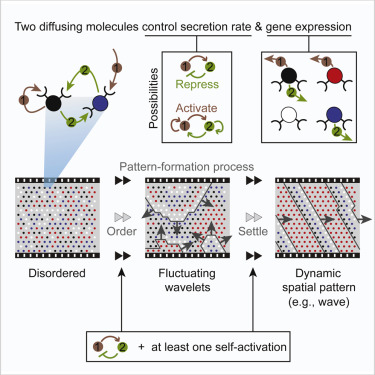Cell Systems ( IF 9.0 ) Pub Date : 2020-01-15 , DOI: 10.1016/j.cels.2019.12.001 Yiteng Dang 1 , Douwe A J Grundel 1 , Hyun Youk 2

|
Cells form spatial patterns by coordinating their gene expressions. How a group of mesoscopic numbers (hundreds to thousands) of cells, without pre-existing morphogen gradients and spatial organization, self-organizes spatial patterns remains poorly understood. Of particular importance are dynamic spatial patterns such as spiral waves that perpetually move and transmit information. We developed an open-source software for simulating a field of cells that communicate by secreting any number of molecules. With this software and a theory, we identified all possible “cellular dialogues”—ways of communicating with two diffusing molecules—that yield diverse dynamic spatial patterns. These patterns emerge despite widely varying responses of cells to the molecules, gene-expression noise, spatial arrangements, and cell movements. A three-stage, “order-fluctuate-settle” process forms dynamic spatial patterns: cells form long-lived whirlpools of wavelets that, following erratic dynamics, settle into a dynamic spatial pattern. Our work helps in identifying gene-regulatory networks that underlie dynamic pattern formations.
中文翻译:

细胞对话:通过可扩散分子进行的细胞间通讯产生动态空间模式。
细胞通过协调它们的基因表达来形成空间模式。一组介观数量(数百到数千)的细胞在没有预先存在的形态发生梯度和空间组织的情况下如何自组织空间模式仍然知之甚少。特别重要的是动态空间模式,例如不断移动和传输信息的螺旋波。我们开发了一种开源软件,用于模拟通过分泌任意数量的分子进行通信的细胞场。有了这个软件和一个理论,我们确定了所有可能的“细胞对话”——与两个扩散分子交流的方式——产生不同的动态空间模式。尽管细胞对分子、基因表达噪声、空间排列和细胞运动的反应差异很大,但这些模式还是出现了。三阶段,“有序-波动-稳定”过程形成动态空间模式:细胞形成长期存在的小波漩涡,随着不稳定的动力学,稳定在动态空间模式中。我们的工作有助于识别构成动态模式形成基础的基因调控网络。











































 京公网安备 11010802027423号
京公网安备 11010802027423号